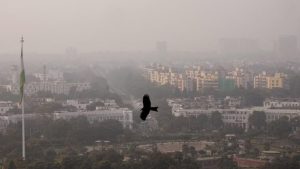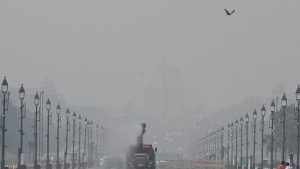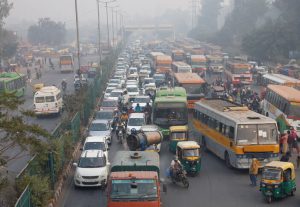The time between November to February is the chilling winter season for north India. It is the time when thick mufflers hide faces of the shivering people and chai shops become comfortable warm spots in the outdoors. But over the past decade, winter season in the northern Indian region has become the alleged season of ‘pollution’. It has become the season of choked nostrils and daily updates on AQI by newspapers. Even though toxic air is a reality for Delhi year round, the winters make it visible more disastrously. Factors from vehicular pollution, stubble burning, and faulty waste incineration to Diwali firecrackers are cited for the persistent toxic atmosphere not only in Delhi but also in other metropolitan areas across North India. For instance, the pollution levels in Chandigarh, India’s first planned city which is about 240km away from Delhi, have been at more than 15 times the safe limit recommended by the World Health Organization (WHO), for more than a month now.

Each year in November, the Supreme Court passes orders directing various authorities to take serious measures. Special boards on pollution control work along with the municipal departments of various cities to work out a plan beforehand to control pollution. However, the problem remains unbattered year after year. The AQI hits an abnormally high record every year, which makes the people of the entire country go in awe. But the real question is, what is this pollution in North India that persists year on year in spite of multiple measures by various authorities, pressure groups and NGOs?
There are many factors that contribute to the pollution in Delhi, and subsequently in the northern part of India. Amongst these, vehicular pollution and dust from construction work contribute the most to the annual poor air quality in Delhi year-round. Other factors include open waste burning, power plants in the region encompassing Delhi, agricultural burning of stubble and festivals that call for firecracker burning. Each one of these factors is taken care of by a separate governing body or control board in Delhi. This makes for multiplicity in the governance of a single problem.
1. AQI and Its Components
The AQI or the air-quality index is a measure for reporting daily air-quality in a particular area. It defines how clean or polluted the air is and helps to predict pollution’s health effects on the human body.
AQI is basically the measure of the density of pollutants present in the air. Eight individual pollutants are monitored to calculate a single composite index. These pollutants are namely PM10, PM2.5, nitrogen dioxide, sulphur dioxide, carbon monoxide, ground-level oxygen, ammonia and lead. Each pollutant has its own sub-index value, which cumulatively forms the bigger index or the AQI.
The oxides of nitrogen and carbon monoxide make up 80% of Delhi’s air pollution, which mainly stems from traffic.
1.1 Year-On-Year Comparison
The mean average of month-wise daily AQI for Delhi was released by the Press Information Bureau, which recorded the AQI from 2018 to 2023.
These trends clearly show that AQI for 2023 between the months of November to February has seen an increment, in comparison to the last few years.
2. Factors
2.1 Vehicular Emissions
The Centre for Science and Environment or CSE is a Delhi-based research and advocacy group that writes on critical environmental issues. The organisation stated, “While meeting the clean air benchmark requires deep cuts in emissions from all sources of pollution in the region, the mobility crisis will require immediate attention and upscale intervention to cut down the prime contributor to the toxic pollution buildup.”
Vehicle emissions contribute up to 51% to the local pollution of Delhi. Delhi’s registered vehicle population has reached up to 7.6 million in recent times from 2.2 million back in 1994. This makes for a growth rate of 14% in vehicle registration per annum. Among these, two-thirds of the motor vehicles registered are two-wheelers. Residents in Delhi are pushing themselves towards private vehicles because of the lack of a robust public transport system. This makes one household own more than two cars.
This is how vehicular pollution became one of the biggest contributing factors to Delhi’s poor air. Delhi started to implement fuel-based standards before any other city in the rest of the country. The BS2 standards were introduced in Delhi in 2001 and were rolled out in the rest of the country in 2005. The Delhi government also attempted the odd-even experiment up to 3 times till 2024, with its first attempt in January 2016. The rules restricted vehicles with registration numbers ending with an odd digit on odd days and an even digit on even days. But that did not render a lot of noticeable difference to the worsening air quality.
This rule excluded Delhi’s large and old fleet of DTC buses and the huge number of two-wheelers. The myth that CNG buses were a cleaner option for transport in Delhi was busted by a real-world vehicle emission study by ICCT released in 2024, which stated that CNG buses emit oxides of nitrogen, which contribute to the formation of secondary PM and ozone.

To add to this, passenger and cargo vehicles from neighbouring states like Haryana and Punjab enter the city every day. All this traffic results in the influx of nitrogen oxides (NOx), accounting for 81% of nitrogen oxide pollution in the city.
A careful analysis of all the data over the past few years suggests that Delhi has been moving fast towards private motorisation, which is resulting in more and more vehicles on the roads of the capital city. In the absence of a good public transport system within the most populous city, people are left with no options but comfortable private vehicles.
2.2 Stubble Burning Not Year Round
The Supreme Court said that farm fires and stubble burning contribute grossly 4% to Delhi’s pollution. This 4% is the value calculated annually, but the episodes of stubble burning in the agricultural states of Haryana and Punjab peak in October. Stubble burning becomes a major problem only in the months of October and November and is not the most important contributing factor in the year-round toxicity of Delhi air.
Still, the sudden rise in pollution during winter is blamed on farm fires and on the lack of awareness in the farming community of India. To clarify this, the Supreme Court ruled that stubble burning cannot explain the year-round poor quality of air. Even if stubble burning is considered for the months of October and November, its contribution remains less than that of factors like vehicles and construction.
This is backed by one of the most authentic reports published by IIT Kanpur on Delhi pollution in the year 2016. The report was steered by two eminent academics, Dr Mukesh Sharma and Dr Onkar Dikshit. According to the report, the major chunk of pollution comes from Delhi’s domestic road dust, which does not get a lot of limelight.

2.3 Construction Dust
The second and third major contributors to domestic pollution include concrete batching, done during the time of new constructions, and 10% from industrial clusters present in NCR. Next comes the contribution from vehicles, which is more dangerous than the above three factors put together because the size of particles emitted from vehicles is smaller in size (SBM 2.5).
2.4 Waste Burning
Along with major factors polluting Delhi, many small sources also contribute. These include the burning of biomass or waste material, which naturally increases during chilling winters. Delhi has many urban villages and poor settlements that still use cow dunk and wood as their primary source of fuel and fire. Other than this, in 2016, there were over 9000 restaurants and Dhaba using tandoors. All this contributes to 26% of daily small particle smog in winters in comparison to only 12% during summers.
At the last is the contribution of solid waste burning inside the city. Delhi burns approximately 3 to 4% of its municipal solid waste. This percentage remains almost the same both during winters and summers because the practice of solid-based burning is a year-round menace.
2.5 Other Sources
Another very interesting observation was made in coal and fly ash pollutants in the air during winter and summer, separately. Coal and fly ash contribute 26% of SPM 2.5 during the summer season while only 5% during the winter season. This is because, during the summer season, the wind blows from the eastern side, bringing industrial fly ash from 11,000 MW of power plants in the periphery of Delhi. During the winter, the wind flows from the western side, bringing smoke from the agricultural states of Haryana and Punjab. But winter is the time when industrial work is halted by the state government. This natural direction of the winds does not support Delhi’s already worst air quality. To top this, Delhi is not situated near a coastline and is landlocked. Also, the city does not witness rainfall evenly year-round, which could have cleared the sky of toxic particles, like in the case of other coastal metropolitan cities like Mumbai.
3. Meteorological Factors
During winters, Delhi witnesses wind inversions, which makes the pollutants settle thickly. The same vehicle pollution that contributed 9% of SBM 2.5 in summers reaches as high as 25% in winters. Alongside, pollution from secondary particles increases from 15% in summers to 30% in winters. The secondary particles include pollution coming from stubble burning in the neighbouring states.
4. Health Impact
Delhi pollution has changed a lot inside our body in terms of blood circulation, heartbeat, lung capacity, and mental satiety. The visible part of this pollution consists of big polluting particles that are of the size of more than 10 µg. However, what is more dangerous are the particles below the size of 2.5 µg, famously called PM 2.5. The human lungs are incapable of filtering the small particles, which sit inside the lungs and cut down space for oxygen.
Daily Newspaper Times Of India reported on Nov 7 that the general rush at OPD, inside AIIMS Delhi, has seen an increase of 15 to 20%. Dr Karan Madan, associate professor in the pulmonary department of Delhi, AIIMS, suspects that these rising cases are for COpD and Asthma.
From the lungs, these toxic particles enter the bloodstream from where they have the potential of affecting each part of the body. In young children and pregnant women, the toxins also hold the potential to affect the cognitive development of the brain. In adults, the small particles can be cancerous. Last year, out of 8,801 deaths, 3,606 were due to pneumonia, 13 were due to acute bronchitis and acute bronchiolitis, and 254 deaths due to asthma. Speaking to PTI, Dr Mukul Mohan Mathur, a senior physician and TB specialist, highlighted a 25-30 per cent spike in respiratory issues such as asthma and bronchitis among older adults.
This makes the people living in North India survive all of the year inside a bubble of toxicity, which does not meet the parameters of minimum air quality standards that the Indian government set years ago. Research shows that humans have lost approximately 2 years of their lives because of pollution, to date. The health of all the residents of the capital city can only be ensured by stopping the assault on our lungs around the year. Therefore, what is required is not tackling pollution through policy interventions only in the months of November to January.
The above-mentioned chart shows the surge in winter pollution in Delhi, between the years 2023 and 2022.
5. Emergency Response Measures in Delhi
The Graded Response Action Plan(GRAP) against pollution is under Stage 4. This means that trucks, other than those carrying essential commodities and running on cleaner fuels, like CNG, LNG, etc, shall not be allowed to enter Delhi. Prohibitions on non-assignable vehicles registered outside Delhi are also banned from entering the city. All construction and demolition activities are also halted, including public infrastructure projects like highways or powerlines. Offices within the capital city are to operate at 50% capacity with the remaining members resorting to work from home medium. The state government authority has issued health warnings for children and entirely.
To ensure an urgent response to address extreme air quality degradation within the capital city, the Commission for Air-Quality Management (CAQM) is monitoring air quality in real-time. Enhancement in weather forecast to direct adjustments in measures from time to time are also in play.

5.1 Action Plan Timeline
India’s National Clean Air Programme was launched five years ago and provided a set budget to 131 Indian cities to respond to the worsening air quality in metropolitans. But according to the latest figures released by the government, the results have been mixed.
The NCAP’s initial target was to reduce major air pollutants: PM 2.5 and PM10 by 20-30% by 2024. However, in September 2022, this target was revised to 40% reduction by 2026.
Out of all the cities under the programme, only 24 cities saw improvement in their PM10 level, while only 27 cities recorded improvement in PM 2.5 levels (from 2019 to 2023). The most significant improvement was seen in Varanasi, where small particles were reduced by 72% and big particles were reduced by 96%.
Contrary to this, several other cities like Mumbai, Ujjain, and Navi Mumbai experienced an increase in PM 2.5.
The Indo Gangetic plain, which stretches from Pakistan in the west to Bangladesh in the east, has the world’s most polluted cities like Lahore, Delhi and Dhaka.
6. Solutions and Initiatives
6.1 Central Government
In 1981, the Indian government passed the Air Act, which defines the standard permissible levels of small and big pollutants in the air. However, the current air toxicity is seven times more than this permissible value. In 2024, some parts of Delhi recorded AQI as high as 15,000 units, falling under the severe category. Because of this, the capital province loses as much as 6% of its annual GDP to air pollution.
The interplay of many factors contributes to the pollution in Delhi and many authorities and bodies are involved. What is required is a synergy amongst all these governing bodies. There needs to be a symphony maintained between the work of the municipal corporation, the Delhi Pollution Control Board, the Delhi government and the government at the centre.
The central government should also set up more research projects to investigate pollution. This will help the government catch hold of the latest figures on pollution, instead of using decade-old stats.
6.2 State and MCD
Environmental activists, think tanks, and academicians have been suggesting major solutions to solve this expanding problem. The most serious solution aims to stop the burning of coal and solid waste inside the national capital region. This can be done by replacing tandoors with electric burners and LPG fuel. The second solution aims to improve the public transport infrastructure of Delhi and phase out the old and dying fleet of CNG buses in the city. In the given time, Delhi has had approximately 1,650 operational electric buses, since January 2022. These collectively saved more than 91,000 tonnes of CO2, according to Delhi Transport Minister, Kailash Gehlot.
Another solution includes water spray or other scientific methods like windbreakers, and telescopic shooters to curb dust from construction sites in Delhi. Vacuum sweeping the roads and water spraying at least four times a month can also ensure a decline in pollution.
The state government has also subsidised solar panel installation. Currently, domestic consumers receive zero bills for up to 200 units monthly consumption while a monthly consumption 50 per cent subsidy is given for 201-400 units. The Delhi Solar Policy, 2023, was announced by Chief Minister Arvind Kejriwal on January 29.
6.3 Citizen
There is a need to switch towards cleaner means of transportation, which can be electric vehicles. An EV’s mileage might not match that of a petrol-based vehicle, but it helps to reduce the cost incurred on fuel and is the future of automobiles in metropolitans. Other than this, there is a need to switch to public modes of transport, like metro rail and buses. Cars should only be allowed where there is space for parking. Options like carpooling can also reduce the road traffic. In spite of carpooling being suggested by the Supreme Court, it is not part of the Motor Vehicle Act, making it illegal. People living in North India need to bring about a conscious change in their mindset that pushes them away from personal vehicles to use more public transport.
6.4 Corporates
There is an urgent need to divert CSR funds towards the environment. Sustainability is very crucial but has a high cost. Clean energy equipment like solar panels and good filtering chimneys have a very high initial cost. The corporates should come forward here in diverting more and more funds towards installing sustainable technologies. The state and corporations should join hands to set up treatment plants and safe waste incineration infrastructures in the city. Corporates should make office timings staggered or divided between home and office space, to reduce traffic during peak hours.
Gurugram Deputy Commissioner Ajay Kumar, under GRAP-4, ordered private and corporate sector companies to allow work from home to 50 per cent of their staff from November 20, as per reports by PTI.





